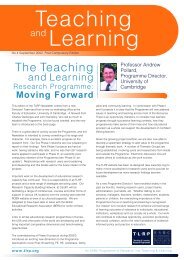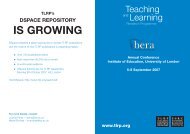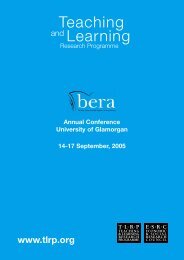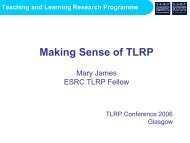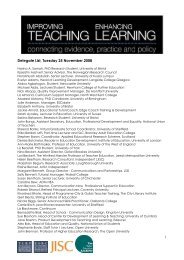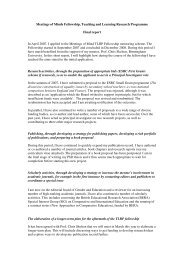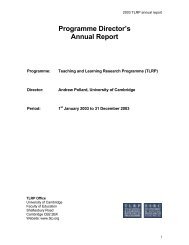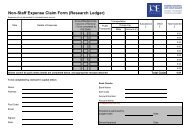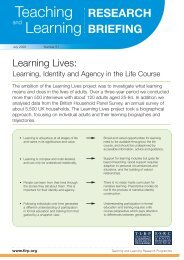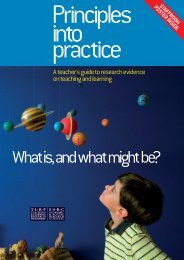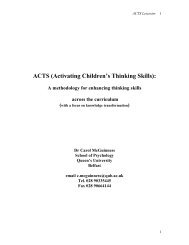Education 2.0? - Teaching and Learning Research Programme
Education 2.0? - Teaching and Learning Research Programme
Education 2.0? - Teaching and Learning Research Programme
- No tags were found...
Create successful ePaper yourself
Turn your PDF publications into a flip-book with our unique Google optimized e-Paper software.
<strong>Education</strong> <strong>2.0</strong>?• sharing of sketches: http://sketchfu.com/• sharing of slideshows: www.slideshare.net/[7] For more details on Wikipedia see www.wikipedia.org[8] For examples of portals which help trace podcasts see www.podcast.net<strong>Education</strong>al hopes <strong>and</strong> fears for web <strong>2.0</strong>[1] For a discussion of ‘boomster’ <strong>and</strong> ‘doomster’ discourses surrounding previous waves of educationtechnology see Bigum, C. <strong>and</strong> Kenway, J. (1998) ‘New information technologies <strong>and</strong> the ambiguous futureof schooling: Some. possible scenarios’ in Hargreaves, A., Lieberman, A., Fullan, M. <strong>and</strong> Hopkins, D.(Eds.), ‘International h<strong>and</strong>book of educational change’ Kluwer, Springer, pp.375-395[2] The popularisation of web <strong>2.0</strong> concepts has been propagated by a number of high-profile books publishedsince 2000. Prominent examples include:• Don Tapscott <strong>and</strong> Anthony Williams (2007) ‘Wikinomics: How Mass Collaboration ChangesEverything’ Atlantic Books• Chris Anderson (2007) ‘The Long Tail: How Endless Choice Is Creating Unlimited Dem<strong>and</strong>’ R<strong>and</strong>omHouse Business Books• Clay Shirky (2008) ‘Here Comes Everybody: The Power of Organizing Without Organizations’ AllenLane• David Weinberger (2007) ‘Everything is Miscellaneous: The Power of the New Digital Disorder’ HenryHolt• Charles Leadbetter (2008) ‘We-Think’ London, Profile• Andrew Keen (2007) ‘The Cult of the Amateur: How Today’s Internet Is Killing Our Culture <strong>and</strong>Assaulting Our Economy’ Nicholas Brealey Publishing• Surowiecki, J. (2004) ‘The wisdom of crowds: why the many are smarter than the few <strong>and</strong> howcollective wisdom shapes business, economies, societies <strong>and</strong> nations’ New York, Little Brown[3] See Kemp J. <strong>and</strong> Livingston, D. (2006) ‘Putting a Second Life “Metaverse” Skin on <strong>Learning</strong> ManagementSystems’ in Livingston, D. <strong>and</strong> Kemp J. (Eds) ‘Proceedings of the Second Life <strong>Education</strong> Workshop’SLCC conference, San Francisco, August, p.13-18. [www.simteach.com/SLCC06/slcc2006-proceedings.pdf][4] See Wales, J. (2008) ‘It’s the next billion online who will change the way we think’ The Observer, 15thJune, p.23[5] The term ‘digital native’ is attributed to Marc Prensky, (see Prenksy, M. (2001) ‘Digital natives, digitalimmigrants’ On the Horizon, 9 ,5, October, pp.1-6). Other examples of the ‘internet generation’ discoursecan be found in:• Wim Veen <strong>and</strong> Ben Vrakking (2006) ‘Homo Zappiens: Growing Up in a Digital Age’ Continuum• Donald F. Roberts, Ulla G. Foehr <strong>and</strong> Victoria Rideout (2005) ‘Generation M: Media in the Lives of29



